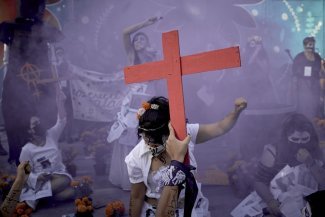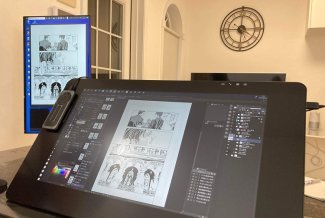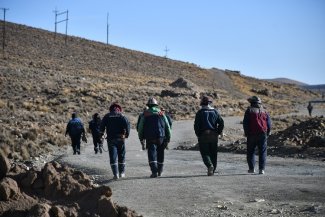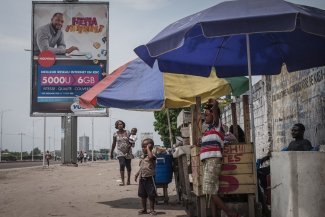Cartoonists across the Arab region are at the forefront of the battle to secure freedom of expression and democracy, despite facing significant opposition and danger, as Khalid Albaih’s “Chase the idea” cartoon (pictured) demonstrates.
Freedom of speech in the Arab Region can come at a very high price, particularly for cartoonists. Even as far back as 1987 when the Palestinian cartoonist Naji Salim Al-Ali, creator of the iconic cartoon Handala, was shot and killed in London by an unidentified assassin, the dangers of biting socio-political criticism in the region have been clear.And since the so-called Arab Spring of 2011, these risks have only increased.
The violent assault of Ali Ferzat, the current head of the Arab Cartoonists’ Association, in 2011 is just one example. Agents of the Syrian regime shattered both his hands in retaliation for his satirical drawings of President Bashar Al-Assad.
The 2013 arrest of the Egyptian cartoonist Magdy El Shafee, author of the acclaimed graphic novel Metro, is another example. He was detained at Egypt’s infamous Tora Prison for trying to stop clashes between anti and pro-Muslim Brotherhood protesters.
But in spite of the dangers, cartoonist across the Arab region continue to fight for free speech.
The Sudanese cartoonist Khalid Albaih, creator of the Facebook page Khartoon!, Nadia Khiari, who created Willis from Tunis to try and make sense of the changes in Tunisia following the fall of Zine al-Abidine Ben Ali’s 23-year rule, and Syrian-Palestian cartoonist Hani Abbas – winner of the 2014 Editorial Cartoon International Prize – are just some of those fighting on the frontline with their political insight and humour. Equal Times spoke with the trio at the Internazionale a Ferrara festival in Italy, last October.
For Khiari, the enduring power of the pen is obvious: “Cartoons are communicative tools. Their strength lies within their direct and quick impact. We live in a disposable society, so it’s important to use images in a smart way. Exposing the absurdity of certain politicians is also a way to fight”.
Albaih, who currently lives in exile in Doha and describes himself as a “virtual revolutionary”, says the internet has been a crucial tool in disseminating his ideas. “I work online, on social media.
People on social media normally do not take the time to read a long text, so I work only on one panel and very simplistically try to ask a question or start a conversation. I try to do cartoons that both my mother and a 16-year-old could understand.”
Albaih, whose father was part of the regime overthrown by President Omar Al-Bashir in 1989, says: “I grew up around politics, and politics is the reason why I do not have a home”.
So it is no surprise that from 2011 onwards, his politically-charged images saw him celebrated as “an artist of the revolution”. Today, activists from Sudan to Yemen to Lebanon use Albaih’s work in support of their movements and ideas.
But for Abbas, social media has brought its own dangers. In 2012, he was threatened by Syrian security agents for drawing a flower to represent the immortality of the Syrian revolution. Fearing for his life, he fled the country and now lives in exile in Switzerland.
“Arab countries are full of contradictions and events. It can go to the form of real confrontation between the cartoonist and the ruling regimes as one comic can take you to jail…and perhaps to death.”
But Abbas admits to feel the pressure of societal constraints, also. “There are a lot of complexities as you cannot draw about certain topics”.
Limits of free speech?
Following the terrorist attacks in Paris last November, the temptation to use fear as a reason to trade-in hard-fought civil liberties for ‘security’ is growing. As a result, cartoonist, journalists and artists are caught between defending free speech and discussing the responsibility that comes with it.
Many Arab cartoonists raised their pencils in solidarity following the gun attack on offices of French satirical magazine Charlie Hebdo, which resulted in 12 deaths.
“I am very sad about what happened, as a colleague of the victims,” says Abbas, but he continues: “I think that the dialogue [about free speech] that took place afterwards is a very important one, in order to understand the mentality of the other, so that you can build on that”.
For Albaih, the tragic events of January 2015 have opened up an important debate: “When you have the power of freedom of speech, would you like to build bridges or widen the gap between people?” he says.
“French, Europeans are always about freedom of speech, ‘We say that about the Pope, Jesus…’ but you do not understand where other people live. We cartoonists have died for reasons way less stupid than drawing the Prophet and historically the Prophet has been drawn. This is not the problem.”
The “problem”, he explains, is something far less complex. “In the Arab Region we do not have heroes. Our politicians are corrupt, our sports are shit, people do not have anything to aspire for, so whether you are religious or not, you believe in that pure person.”
All of this means that being a political cartoonist in the Arab region carries a great deal of responsibility. “We do cartoons not because we want to make funny gags. It’s a life and death situation for us, every day. If you want to make a joke, that’s excellent, but for us it’s not a joke, it’s our life.”
Arab Winter?
Amongst the many popular Western media narratives on the region is the idea that the ‘Arab Spring’ has evolved into an ‘Arab Winter’.
But for Abbas this is disingenuous. “About the Arab revolutions, I ask the world powers this: ‘What have you done for this Spring?’ Why did not you stand with the people?’ The Western world asked Arabs to move for freedom and revolution, but at the same time it stood with the dictators!”
The fall of Tunisian and Egyptian presidents Ben Ali and Hosni Mubarak in January 2011 and February 20111 respectively, provided an important opportunity to improve relations between the West and the Arab world. But, as proved by the recent visit to the UK of Egypt’s former army chief now president, Abdel Fatah Al Sisi, human rights violations are no obstacle to business deals and diplomacy.
One of the major geopolitical outcomes post-2011, however, has been the power and cultural shift from the traditional capitals of the Arab World such as Cairo, Baghdad and Beirut towards Gulf metropoles like Abu Dhabi, Dubai and Doha.
Albaih, who is co-founder of the Khartoum Contemporary Art Centre and also heads the installation and design team for public art at the Qatar Museum Authority, says that with new political centres come new centres for art and dissent; he believes that the consolidation of both physical and virtual spaces for free expression is a pressing challenge.
“After the Arab Spring, everybody was positive and dying for free expression. Now with everything that’s happening, we are in transition, but also a lot of art is being produced. It’s a process and it’s happening and our job as intellectuals and artists is to help this change”.
While Khiari rejects the ‘Arab Winter’ title, she too admits that the struggle to build free and fair societies across the Arab world has only just begun: “Our situation [in Tunisia] in comparison to other countries that have experienced this Spring is pretty good.
"But this happened because freedom, dignity, work, the struggle against social injustice, corruption and nepotism made this revolution. Unfortunately, these problems are still there. The democratic process takes a lot of time.
“Freedom of speech [in Tunisia] is one of the only concrete victories of that revolution. We have been killed for decades. While we can speak and despite the attempts of silencing us, I exercise this fundamental right that has been earned at the price of many sufferings and human lives, in Tunisia or elsewhere. If we give up to fear, we’re lost”.










